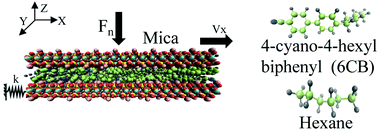当前位置:
X-MOL 学术
›
Phys. Chem. Chem. Phys.
›
论文详情
Our official English website, www.x-mol.net, welcomes your
feedback! (Note: you will need to create a separate account there.)
Nanoscale liquid crystal lubrication controlled by surface structure and film composition†
Physical Chemistry Chemical Physics ( IF 2.9 ) Pub Date : 2018-06-25 00:00:00 , DOI: 10.1039/c8cp03353f Pritam Kumar Jana 1, 2, 3, 4, 5 , Wei Chen 6, 7, 8, 9, 10 , Mikko J. Alava 1, 2, 3, 4, 5 , Lasse Laurson 1, 2, 3, 4, 5
Physical Chemistry Chemical Physics ( IF 2.9 ) Pub Date : 2018-06-25 00:00:00 , DOI: 10.1039/c8cp03353f Pritam Kumar Jana 1, 2, 3, 4, 5 , Wei Chen 6, 7, 8, 9, 10 , Mikko J. Alava 1, 2, 3, 4, 5 , Lasse Laurson 1, 2, 3, 4, 5
Affiliation

|
Liquid crystals have emerged as potential candidates for next-generation lubricants due to their tendency to exhibit long-range ordering. Here, we construct a full atomistic model of 4-cyano-4-hexylbiphenyl (6CB) nematic liquid crystal lubricants mixed with hexane and confined by mica surfaces. We explore the effect of the surface structure of mica, as well as lubricant composition and thickness, on the nanoscale friction in the system. Our results demonstrate the key role of the structure of the mica surfaces, specifically the positions of potassium (K+) ions, in determining the nature of sliding friction with monolayer lubricants, including the presence or absence of stick-slip dynamics. With the commensurate setup of confining surfaces, when the grooves created between the periodic K+ ions are parallel to the sliding direction we observe a lower friction force as compared to the perpendicular situation. Random positions of ions exhibit even smaller friction forces with respect to the previous two cases. For thicker lubrication layers the surface structure becomes less important and we observe a good agreement with the experimental data on bulk viscosity of 6CB and the additive hexane. In case of thicker lubrication layers, friction may still be controlled by tuning the relative concentrations of 6CB and hexane in the mixture.
中文翻译:

受表面结构和膜组成控制的纳米级液晶润滑†
由于液晶倾向于表现出长程有序性,因此液晶已成为下一代润滑剂的潜在候选者。在这里,我们构建了一个完整的4-氰基-4-己基联苯(6CB)向列型液晶润滑剂与己烷混合并受云母表面约束的原子模型。我们探索了云母的表面结构以及润滑剂组成和厚度对系统中纳米级摩擦的影响。我们的结果证明了云母表面结构的关键作用,特别是钾(K +)离子的位置,在确定与单层润滑剂的滑动摩擦的性质(包括是否存在粘滑动力学)方面起着关键作用。随着约束表面的相应设置,当在周期K +离子平行于滑动方向,与垂直情况相比,我们观察到较低的摩擦力。相对于前两种情况,离子的随机位置表现出甚至更小的摩擦力。对于较厚的润滑层,表面结构变得不那么重要,我们观察到与6CB体积粘度和添加剂己烷的实验数据吻合良好。对于较厚的润滑层,仍然可以通过调节混合物中6CB和己烷的相对浓度来控制摩擦。
更新日期:2018-06-25
中文翻译:

受表面结构和膜组成控制的纳米级液晶润滑†
由于液晶倾向于表现出长程有序性,因此液晶已成为下一代润滑剂的潜在候选者。在这里,我们构建了一个完整的4-氰基-4-己基联苯(6CB)向列型液晶润滑剂与己烷混合并受云母表面约束的原子模型。我们探索了云母的表面结构以及润滑剂组成和厚度对系统中纳米级摩擦的影响。我们的结果证明了云母表面结构的关键作用,特别是钾(K +)离子的位置,在确定与单层润滑剂的滑动摩擦的性质(包括是否存在粘滑动力学)方面起着关键作用。随着约束表面的相应设置,当在周期K +离子平行于滑动方向,与垂直情况相比,我们观察到较低的摩擦力。相对于前两种情况,离子的随机位置表现出甚至更小的摩擦力。对于较厚的润滑层,表面结构变得不那么重要,我们观察到与6CB体积粘度和添加剂己烷的实验数据吻合良好。对于较厚的润滑层,仍然可以通过调节混合物中6CB和己烷的相对浓度来控制摩擦。











































 京公网安备 11010802027423号
京公网安备 11010802027423号